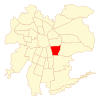Macul facts for kids
Quick facts for kids
Macul
|
|||||
|---|---|---|---|---|---|

Vásquez Palace, the town hall for the Municipality of Macul.
|
|||||
|
|||||
| Country | Chile | ||||
| Region | Santiago Metro. | ||||
| Province | Santiago | ||||
| Government | |||||
| • Type | Municipality | ||||
| Area | |||||
| • Total | 12.9 km2 (5.0 sq mi) | ||||
| Population
(2002 Census)
|
|||||
| • Total | 112,535 | ||||
| • Density | 8,720/km2 (22,590/sq mi) | ||||
| • Urban | 112,535 | ||||
| • Rural | 0 | ||||
| Sex | |||||
| • Men | 53,667 | ||||
| • Women | 58,868 | ||||
| Time zone | UTC-4 (CLT) | ||||
| • Summer (DST) | UTC-3 (CLST) | ||||
| Area code(s) | 56 + | ||||
| Website | Municipality of Macul | ||||
Macul is a city and local government area, called a commune, in Chile. Its name comes from the Quechua language and means "to stretch out right hand". It is located in the central-eastern part of the Greater Santiago area. Macul shares borders with other communes like Ñuñoa to the north and La Florida to the south.
Macul is mostly a place where people live and where factories are located. However, it has been growing and changing a lot. This means new buildings and facilities are being added. Most people living in Macul are considered middle class.
Contents
Macul's History
Before the Spanish arrived, Macul was one of five native villages in the Ñuñohue region. The people living there grew a lot of crops because the soil was very good for farming.
Changes Over Time
In the 1600s, the Ñuñoa area, which included Macul, was still mainly farmland. But roads started to connect it more strongly with the city of Santiago. During the 1800s, many things changed. Railways were built, new houses appeared, and a law was passed that gave local areas more control over themselves.
By the 1930s, Ñuñoa became more focused on homes. Because it was easy to get around and communicate with other parts of the city, many factories also moved there.
Becoming an Urban Area
In the 1960s, Macul stopped being just an area for Santiago to expand into. It became a fully developed urban area. This development continued into the early 1970s with the opening of the Américo Vespucio Ringroad.
In 1981, the larger area of Ñuñoa was divided into three separate communes: Ñuñoa, Peñalolén, and Macul. Macul officially became its own local government in 1984. Before this, Macul had many factories. Since 1992, the local leaders are chosen by public vote every four years.
How Macul is Governed
As a commune, Macul is a local government area in Chile. It is managed by a municipal council. The leader of this council is called an alcalde (mayor), who is elected by the people every four years. The mayor from 2012 to 2016 was Sergio Puyol Carreño. The council also has several members who help make decisions for the community.
Local Participation
The commune is divided into twenty neighborhood units. These units have groups where neighbors can meet. They work together to find solutions for common problems and concerns in their local area.
Macul is also part of larger areas for national elections. This means its citizens vote for people to represent them in the national government, like in the Chamber of Deputies and the Senate.
Education in Macul
Macul is home to several important educational institutions.
Universities and Colleges
The Pontifical Catholic University of Chile has its San Joaquín Campus in Macul. This campus has many different departments, labs, libraries, and sports fields. Some buildings on campus were designed by a famous architect named Alejandro Aravena.
The University of the Americas also has a sports campus in Macul, called Campus One. This campus was created to encourage physical activity among university students.
Another higher education institution in Macul is INACAP. Its campus in Macul is the largest INACAP campus in Chile. It has a huge amount of floor space and land, making it a big learning center.
Fun Places to Visit in Macul
Macul has several interesting places to see and visit.
Sports and Recreation
You can find the Aquatic Club Macul, which is a place for water activities. Macul is also home to the Estadio Monumental David Arellano. This is the stadium for Colo-Colo, one of Chile's most popular football (soccer) teams. The training center for the Chilean national football team, Juan Pinto Durán, is also located here.
Historical Building
The Vasquez Palace, also known as "The Macul Castle," is a beautiful building in the center of the community. It's a popular place for visitors. Besides being a tourist attraction, this palace also serves as the main office for the local government.
Macul's Population
According to a census taken in 2002, Macul covers an area of about 12.9 square kilometers (about 5 square miles). It had 112,535 people living there at that time. Out of these, 53,667 were men and 58,868 were women. The entire commune is considered an urban area, meaning it's a city environment. Between 1992 and 2002, the population of Macul decreased by about 6.8%.
Images for kids
See also
 In Spanish: Macul para niños
In Spanish: Macul para niños





